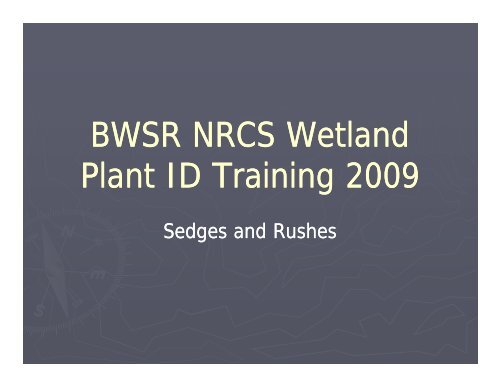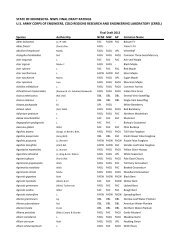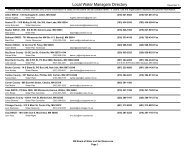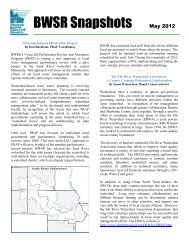Wetland Plant ID-Sedges and Rushes
Wetland Plant ID-Sedges and Rushes
Wetland Plant ID-Sedges and Rushes
You also want an ePaper? Increase the reach of your titles
YUMPU automatically turns print PDFs into web optimized ePapers that Google loves.
BWSR NRCS <strong>Wetl<strong>and</strong></strong><br />
<strong>Plant</strong> <strong>ID</strong> <strong>ID</strong> Training T aining 2009<br />
2009<br />
<strong>Sedges</strong> <strong>and</strong> <strong>Rushes</strong>
Carex - True <strong>Sedges</strong><br />
(F (Family il : C Cyperaceae) )<br />
►Triangular Triangular stems<br />
stems<br />
►3 3 leaves<br />
►Bisexual Bisexual or unisexual<br />
Both male <strong>and</strong> female on same spikelet<br />
Male <strong>and</strong> <strong>and</strong> female on on different spikelets<br />
Male <strong>and</strong> female on different plants<br />
►Florets Florets terminal or lateral<br />
►Achenes Achenes enclosed in a perigynium
Male <strong>and</strong> Female flowers<br />
separate<br />
Male<br />
Gynec<strong>and</strong>rous<br />
Female<br />
Androgynous
Questions to ask yourself when<br />
<strong>ID</strong>i <strong>ID</strong>ing CC Carex Carex spp.<br />
► Sheath: S eat g glabrous ab ous o or pubesce pubescent t<br />
► Sheath: Lattice of fibers or papery<br />
► Sheath: color? (green, (g , purplish, p p , brown, , etc.) )<br />
► Spikes: Separate male <strong>and</strong> female, gynec<strong>and</strong>rous<br />
or <strong>and</strong>rogynous<br />
► Spikes: upright, sessile, peduncled<br />
► Perigynia: length<br />
► Perigynia: pubescent b or glaucous l<br />
► Achene: 2 or 3 sided
Lake Sedge<br />
C Carex lacustris l t i<br />
► Leaves coarse, , MM-shaped,<br />
shaped, p , blue blue-<br />
green<br />
► Lower sheath red to purplish<br />
with lattice lattice of fibers<br />
► Pistillate spikelets attach<br />
directly to the stem or have<br />
short stalks<br />
► 2-4 4 staminate spikelets<br />
► Perigynium gy has no hairs,<br />
distinctly ribbed, <strong>and</strong> tapers into<br />
a beak. 3-angled 3 angled nutlet
Lake Sedge<br />
Carex CCCarex lacustris lacustris<br />
ll tt ii
Slough Sedge<br />
CCCarex Carex atherodes atherodes th th dd<br />
► Hairs present on leaves <strong>and</strong><br />
sheaths!! h th !!<br />
► Purplish at base with lattice of<br />
fibers<br />
► Perigynium has no hairs,<br />
distinctly ribbed, <strong>and</strong> tapers into<br />
a beak. 3-angled 3 angled nutlet
► Stems usually y longer g<br />
than the leaves<br />
(slender)<br />
► Leaves are V shaped<br />
► Forms large hummocks<br />
► Lower sheath with<br />
lattice of fibers<br />
► Perigynia are relatively<br />
flat <strong>and</strong> lack beaks<br />
Hummock sedge<br />
CCCarex Carex stricta stricta tt ii tt<br />
OBL
Hummock sedge<br />
CCCarex Carex stricta stricta<br />
tt ii tt
Stalk Stalk-grained grained sedge<br />
Carex Carex Carex Carex stipata stipata stipata stipata OBL<br />
► Winged g triangular g stems<br />
► Coarse MM-shaped<br />
shaped leaves are<br />
usually shorter than the stem<br />
► Whitish thin thin wrinkled wrinkled sheaths<br />
sheaths<br />
at the base<br />
► Perigynium is lance lance-shaped shaped<br />
with ith a beak b k less l than th twice t i<br />
as long as the body.<br />
► Inflorescence appears pp prickly p y
Stalk Stalk-grained grained sedge<br />
Carex CCCarex stipata stipata<br />
ti ti tt
Fox Sedge<br />
Carex Carex vulpinoidea<br />
vulpinoidea OBL<br />
► Clump Cu Clump-forming p forming o g<br />
► Leaves generally longer<br />
than the stem<br />
► Bristle Bristle-like like bract at base<br />
of some spikelets<br />
► St Stems are fi firm with ith<br />
whitish, thin wrinkled<br />
sheaths<br />
► Perigynia are lance lance-ovate ovate<br />
<strong>and</strong> taper into a beak.
Fox Sedge<br />
CCCarex Carex vulpinoidea<br />
vulpinoidea<br />
ll ii id id
Scirpus - Bulrushes<br />
(Family : Cyperaceae)<br />
►Solid Solid stem; some<br />
round, some triangular<br />
►Leaves Leaves present<br />
►Florets Florets usually whorled<br />
►Florets Florets are bisexual in<br />
same seed head
Softstem Bulrush<br />
Schoenoplectus<br />
tabernaemontani<br />
(Scirpus (Scirpus validus) validus)<br />
OBL<br />
► Round Round stem<br />
stem<br />
► Stems spongy <strong>and</strong><br />
easily compressed<br />
► More than 10<br />
spikelets p ( (less than<br />
10mm long)
Hardstem Bulrush<br />
Si Scirpus acutus t OBL
River Bulrush<br />
Scirpus fluviatilis OBL<br />
► Sharply triangle<br />
triangle<br />
stem<br />
► Terminal Terminal spike<br />
spike<br />
► Spikelets 11-3<br />
3 cm<br />
long<br />
► Peduncle <strong>and</strong><br />
sessile
Green Bulrush<br />
Scirpus Scirpus atrovirens<br />
atrovirens<br />
► Rounded triangle<br />
stem t<br />
► Terminal spike<br />
► Spikelets 22-8mm<br />
8mm<br />
long<br />
► P Peduncle d l <strong>and</strong> d<br />
sessile spherical<br />
clusters clusters of spikelets<br />
► Sheaths green or<br />
brown brown (no (no red)
Green Bulrush<br />
Scirpus Scirpus atrovirens atrovirens OBL
Andrew Hipp<br />
Woolgrass<br />
Si Si Scirpus Scirpus cyperinus cyperinus ii<br />
OBL<br />
► Nearly round round stem<br />
► Terminal spike<br />
► Spikelets 33-8mm<br />
33-8mm<br />
8mm<br />
long<br />
► Peduncled<br />
► Sheaths green or<br />
brown b bbrown o ( (no o red) ed)<br />
► Appearing woolly –<br />
long g<br />
bristles
Woolgrass<br />
Si Si Scirpus Scirpus cyperinus cyperinus<br />
ii
► Triangle g stem<br />
► Leaves light yellowish-<br />
green, mostly basal<br />
► Terminal Terminal inflorescence<br />
inflorescence<br />
► Spikelets are bright<br />
yellow, y , extending g<br />
perpendicular to the<br />
main stem.<br />
► Each spikelet spikelet “branch” branch<br />
is 33-12cm<br />
12cm long<br />
► Scales are 22-3mm<br />
3mm long<br />
Yellow Nutsedge<br />
Cyperus CCCyperus esculentus esculentus ll tt<br />
Illus: Weeds of the North Central States
Yellow Nutsedge<br />
Cyperus Cyperus esculentus esculentus
Eleocharis Eleocharis - Spikerushes<br />
(Family : Cyperaceae) All FACW or OBL<br />
►Round Round solid stem (usually)<br />
►“Leafless” “Leafless”<br />
►Terminal Terminal spike<br />
spike<br />
►Florets Florets usually whorled<br />
Blunt Spikerush
Bald Spikerush<br />
Dwarf Spikerush<br />
Common Spikerush
Juncus – True <strong>Rushes</strong><br />
(Family (F (Family il : Juncaceae)<br />
J )<br />
►Solid Solid round (generally) stem<br />
►Fruit Fruit is a capsule with many seeds<br />
►Flowers Flowers are bisexual; lateral or terminal<br />
Soft/Common Rush
►10 10-80 10 80 cm tall<br />
Slender Rush<br />
Juncus JJJuncus tenuis tenuis tt ii FAC FAC FAC FAC<br />
80 cm tall Slender Rush<br />
Rush<br />
►Basal Basal leaves only, 1/3<br />
the the height height of the stem<br />
►Flowers Flowers born singly<br />
►Terminal Terminal flower head<br />
►Tepals Tepals p often equal q or<br />
longer than capsule<br />
tepals









